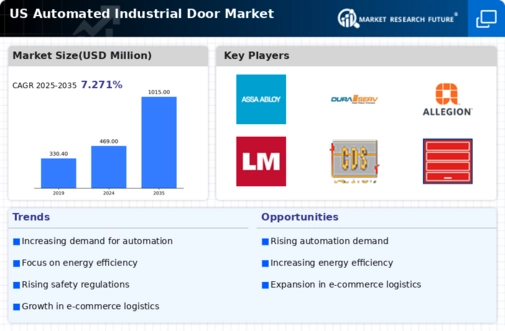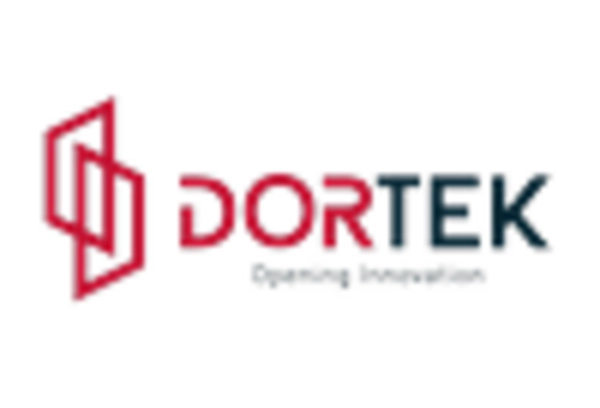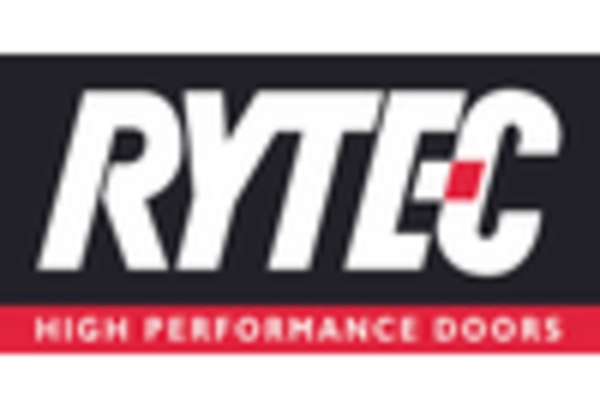Rising Demand for Safety Features
The automated industrial-door market experiences a notable increase in demand for enhanced safety features. As industries prioritize worker safety, regulations and standards evolve, necessitating the integration of advanced safety mechanisms in automated doors. This trend is particularly evident in sectors such as manufacturing and logistics, where the risk of accidents is higher. The incorporation of sensors, emergency stop functions, and safety interlocks not only complies with safety regulations but also enhances operational efficiency. In 2025, the market for safety-enhanced automated doors is projected to grow by approximately 15%, reflecting the industry's commitment to safeguarding personnel and assets. Consequently, manufacturers are compelled to innovate and offer solutions that align with these safety requirements, thereby driving growth in the automated industrial-door market.
Growth in E-commerce and Logistics
The automated industrial-door market benefits significantly from the expansion of e-commerce and logistics sectors. As online shopping continues to surge, warehouses and distribution centers are increasingly adopting automated solutions to streamline operations. Automated doors facilitate efficient loading and unloading processes, reducing wait times and enhancing productivity. In 2025, the logistics sector is expected to account for over 30% of the total demand for automated doors, driven by the need for rapid and efficient movement of goods. This trend indicates a shift towards automation in material handling, prompting manufacturers to develop doors that cater specifically to the high-volume demands of e-commerce operations. The growth in this sector not only boosts sales but also encourages innovation in design and functionality within the automated industrial-door market.
Technological Advancements in Automation
Technological advancements play a pivotal role in shaping the automated industrial-door market. Innovations such as IoT integration, AI-driven controls, and advanced materials are transforming how automated doors operate. These technologies enhance functionality, allowing for real-time monitoring and predictive maintenance, which can significantly reduce downtime. In 2025, it is anticipated that the adoption of smart technologies will increase by 20%, as businesses seek to optimize their operations and reduce costs. The integration of these technologies not only improves efficiency but also provides a competitive edge in a rapidly evolving market. As a result, manufacturers are increasingly investing in R&D to develop cutting-edge solutions that meet the demands of modern industries, thereby propelling growth in the automated industrial-door market.
Increased Focus on Operational Efficiency
The automated industrial-door market is witnessing a heightened focus on operational efficiency across various industries. Businesses are increasingly recognizing the importance of optimizing workflows to reduce costs and improve productivity. Automated doors facilitate seamless transitions between different operational areas, minimizing delays and enhancing overall efficiency. In 2025, it is estimated that companies investing in automation solutions will see a return on investment of up to 30% due to improved operational performance. This trend encourages manufacturers to develop doors that not only meet functional requirements but also contribute to the overall efficiency of industrial operations. As a result, the automated industrial-door market is likely to experience sustained growth as businesses continue to prioritize efficiency in their operations.
Sustainability and Environmental Regulations
The automated industrial-door market is increasingly influenced by sustainability initiatives and environmental regulations. As industries strive to reduce their carbon footprint, there is a growing emphasis on energy-efficient automated doors. These doors are designed to minimize energy consumption, often incorporating features such as insulated panels and energy-efficient motors. In 2025, the market for energy-efficient automated doors is projected to grow by 25%, driven by regulatory pressures and consumer demand for sustainable solutions. Companies are compelled to adopt greener practices, which not only comply with regulations but also enhance their brand image. This shift towards sustainability is likely to foster innovation in materials and design, further stimulating growth within the automated industrial-door market.

















Leave a Comment